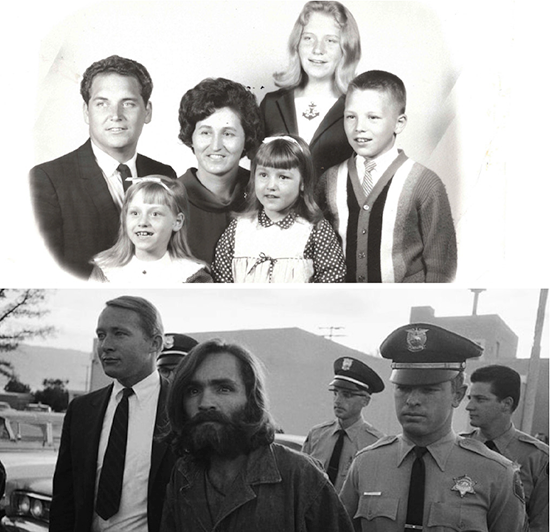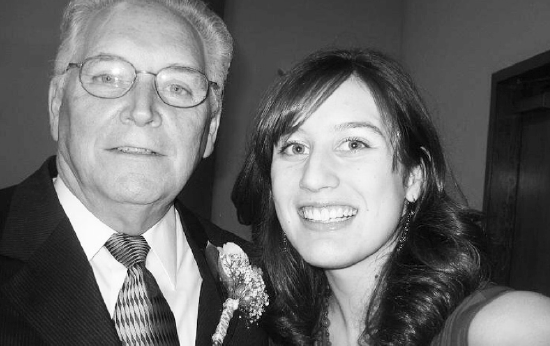
June-July 2018
Surrendering
My Places
------------------
|






All the Difference
By Ashley Baines McNeese
In 1934 and 1935, just ten months apart, two baby boys were born at Cincinnati General Hospital. While their individual circumstances were not identical, both boys were dealt a nearly unplayable hand in life. Despite the lackluster beginnings, each achieved notoriety as adults, though in wildly opposite ways. The paths that nearly crossed in Ohio eventually intersected at a reform school in Indiana. From there, both tried to become something more than what life seemed to dictate, but only one truly overcame his “demons”; the other embraced them.
The first boy, Charlie, channeled every ounce of rejection and inferiority into creating an environment in which he had complete control. The cruel, manipulative spirit that appeared in his childhood manifested first in small crimes and then escalated in unthinkable ways. Young Charlie became Charles Milles Manson, leader of “The Family” and one of the most notorious mass murderers of the 20th century.
The other boy, in some ways, faced even darker days than Charlie. His childhood was an emotional roller coaster, with little love and strict discipline on the best of days, neglect and abuse on the worst. He experienced a violent trauma firsthand. In one night, childhood ended. On his own by age 12, he too began to dabble in small-time crime. But from reform school, Richard Ray Cordell went on to become a man that would have been incomprehensible to him as a boy on the streets: successful pastor, dedicated family man, evangelist, educator…and my grandfather.
As a little girl, I knew “Papaw” was an extraordinary person. It never occurred to me his past resembled an unfinished puzzle to the family, and he rarely volunteered the missing pieces. I was fascinated to learn he had crossed paths with Charles Manson, and research revealed some astonishing parallels. Poet Robert Frost famously described two roads, the choices they offer, and “the difference” made by taking “the road less traveled.” Although Charles Manson and Richard Cordell began in similar ways, their personalities, choices, and ultimately faith in Christ for my grandfather made all the difference.
Charlie
Charlie was born Charles Milles Maddox on November 12, 1934. His mother Kathleen was only 16 years old. His biological father, Colonel Scott, never claimed him as a son, and Kathleen’s later marriage to William Manson lasted less than three years. Charlie received his stepfather’s last name, but not the father he desperately needed. Kathleen, despite the needs of her young son and the protests of her devoutly Christian mother, preferred partying to parenting. By 1939, before Charlie was five, Kathleen was arrested and sentenced to five years in jail following a robbery attempt with her brother Luther.
Charlie stayed with Bill and Glenna Thomas, Kathleen’s brother-in-law and sister. By all accounts, they treated him like a son. Strict disciplinarians, they instructed their eight-year-old Jo Ann to watch out for Charlie like an older sister. At age five, Charlie was already a handful. His cousin recalls, “There was never anything happy about him. He never did anything that was good.” Sadly, Charlie would be described in similar terms throughout his youth.
After his mother’s release, the Thomas family was relieved to see Charlie go. Kathleen’s plans to settle down and provide a stable life for him were soon derailed by her return to “nightlife” and the fact that nine-year-old Charlie was completely beyond her control. While Kathleen attempted to earn an honest living and restore order to her only son’s life, the efforts were too little, too late. Marriage to an alcoholic with no patience for Charlie’s antics did not help.
By 1947, Kathleen had come to fear her “crazy-eyed” son. She enrolled him in the Gibault School for Boys in Terra Haute, Indiana, after being denied a request to place him in foster care. He ran away from Gibault after less than a year and began a string of petty crimes that soon escalated. After joining in two armed robberies, 13-year-old Charlie qualified for a harsher punishment. He was sentenced to the Indiana Boys’ School in Plainfield for three years. With each new choice life offered, Manson invariably opted for the wrong one. He seemed to have a propensity for deception, manipulation, and cruelty.
At 13, Charlie was small for his age, which made him an easy target for abuse. He later claimed he was sexually assaulted soon after arriving in Plainfield, allegedly at the encouragement of a staff member. Rather than choosing to stop the cycle of abuse, he abused others in turn. By age 17, he had been charged with eight serious disciplinary offenses, three involving homosexual acts. Charlie made six attempts to escape Plainfield, and he and other boys claimed they were beaten almost daily, with little provocation. Those were hard times in a hard world. Manson was not interested in reform but survival.
Despite the atrocities he later commited, Charlie’s story is heartbreaking. A report written when he was 16 describes “an extremely sensitive boy who has not yet given up in terms of securing some kind of love and affection from the world.” His mother only belatedly tried to repair the damage her early neglect caused. While his extended family fulfilled their duty to care for him and disciplined his actions, they never reached his heart. By the time he reached Plainfield, he viewed life through a lens of injustice and entitlement fostered by a childhood of rejection and want.
Richard
Richard Ray Cordell was born on August 28, 1935, in Cincinnati, Ohio, to Robert and Myrtle “Mae” Cordell. He had four older half siblings, but Richard was the first child born to Robert and Mae. Two more boys were added to the family: David just 15 months after Richard, and Clarence nearly eight years later.
After a naval career, Robert ran a successful business as a typewriter and adding machine mechanic. He sometimes took Richard, known as “Corkey” to the family, to work and once even as far as a trip to the Great Lakes Naval Base in Illinois, where he had been stationed previously. Richard picked up many of the skills of his father’s trade, including typing. As a kid tagging along with his dad, he had no way of knowing how useful those skills would become a few years later.
Robert expected his children to be respectful, to use good manners, and to work hard, modeling this lesson by working hard himself. He was tough, especially on the boys, but most men were in those days. On the surface, it seemed Robert treated his children well, taught them right from wrong, and provided for the family. Alcohol changed all that. When drinking, he transformed, becoming malicious, violent, and, worst of all, uninhibited. Robert sexually assaulted his stepdaughter on multiple occasions. Over 70 years later, she recalled, “He treated me well, like his own daughter, when he was sober. But when he drank he became a different person.” It is impossible to know how long or how often this abuse continued.
Mae’s drinking was worse than Robert’s. While Robert indulged infrequently and, fortunately for his children, rarely stayed drunk long, Mae’s binges lasted weeks at a time. By the time her youngest brother Butch was born, Nan “mothered” all three of the younger boys. By age ten, she shouldered much of the responsibility of running the household while her mother was incapacitated. Mae had a mean streak. Rather than protecting Nan from Robert or seeking help for her alcoholism, she neglected the children and expressed more jealousy than sympathy of Robert’s abuse of Nan. Her selfishness came to the forefront at a time when her family needed her most.
While the household was dysfunctional, it did function in a rhythm of sorts. A drunken binge would end, life would return to “normal,” with both parents around, and then the cycle would repeat. This life, while hardly stable, suddenly screeched to a halt and destroyed any semblance of the “family” that remained.
Clarence Ethridge, Mae’s brother, was a 20-year Marine veteran who spent the year before his discharge being treated for mental illness. After his release, he ended up in the Cordell home, but he and Robert fought often. One day their arguing grew heated, and Robert kicked Clarence out of the house, locking the door and telling him he was no longer welcome.
That night, July 19, 1947, Clarence returned with a gun. According to the police report and newspaper articles, Clarence “kicked in the kitchen door and entered the house, brandishing a .32-caliber blue steel automatic.” He gathered the family, forced them to lie across the bed, and yelled and cursed at Robert for a time before allowing Mae to put two-year-old Butch to bed. After they left the room, Clarence fired several times at his brother-in-law, striking him twice in the chest and once in the face. The shots killed Robert instantly. Mae, carrying Butch, broke through a plate-glass window and ran through the yard with Clarence on her heels. She made no attempt to get the rest of the family to safety—not surprising, perhaps, but almost incomprehensible. She ran off into the night, leaving three of her children behind with a crazed gunman and the bleeding body of their murdered father.
Clarence shot at her and missed, eventually turning back after promising to return and kill the whole family. Fortunately, he never followed through on his threat and fled the state. Police apprehended him a month later in Clinton, Tennessee. Escorted back to Indiana for trial, he was eventually convicted of second-degree murder.
For decades, no one knew exactly what Clarence and Robert were arguing about. Clarence told police that killing Robert was “the climax of a family feud of long standing,” that he would not hesitate to repeat his actions if given the chance. Court records indicate Clarence had confronted Robert about his relationship with his stepdaughter. To their horror, however, the family eventually learned both men had been sexually abusing 14-year-old Nan, and their fight somehow centered upon that abuse.
The effects on the children, particularly Richard, are incalculable. When asked about this night throughout his life, he would sometimes answer briefly. Often, he would simply begin to cry and say, “I can’t talk about it.” One can only imagine the terror that gripped the 11-year-old little boy experiencing this shocking taste of violence, in which both victim and perpetrator
were family.
Sometime after his father’s murder and perhaps during the upheaval of the trial, Mae told Richard he was on his own. After the trial, she left Indiana for Arkansas, where her mother lived, and she made it clear “Corkey” would not make the move.
Alone on the streets at age 12, he slept in doorways and on park benches. Eventually, he got a job at a laundry shop and apparently attempted to forge a check and was sent to the Indiana Boys’ School. Since boys were sent to Plainfield only for serious infractions, the forged check was probably not his first encounter with the law. Unlike Charlie’s crimes, which he treated like a game, Richard’s survival tactics were born from desperation.
Plainfield
The school functioned much like its own small town, with gardens, orchards, and animals, as well as woodworking, machine repair, and more. The boys were expected to fulfill these duties and learn a trade in the process, preparing them for adulthood outside the home. Charlie and Richard met when both were assigned to kitchen chores. Richard later recalled that Charlie, “a scrawny kid that everyone picked on,” seemed to look up to him. While Charlie had an awkward, almost backward way with people, Richard was, by all accounts, a well-liked young man who interacted easily with both adults and peers. He was athletic, intelligent, and possessed an impressive skill with typewriters and other equipment his father had taught him to repair.
Since Richard spoke so rarely about Plainfield, it is likely he experienced some degree of the (apparently commonplace) abuse. One couple who lived on campus and functioned as “house parents” took a liking to Richard, allowed him to spend time with their family and even babysit their young children. It speaks volumes that an institution filled with delinquent young men identified something in Richard that earned their trust. Their interest not only made his time at the school more bearable, but it also introduced him to Christ. Their love for the Lord, each other, and even for him, was unlike anything Richard had ever seen. Although he did not trust Christ at the time, the seeds of the gospel were planted. He often thought, “If I ever have a family, I want what they have.”
It seems unlikely anyone ever extended the same warm welcome to Charlie. His unpleasantness was off-putting, even to his own family, and the environment at Plainfield, where allegations of sexual assault and promiscuity were rampant, apparently did little to discourage that culture. Allegations of excessive physical force by staff members persisted years later, lending credibility to the claims made by Charlie and others.

Photo: Richard Cordell and family, 1969; Charles Manson, 1969.
Choices and Consequences
By 1969, Charles Manson and Richard Cordell had made decisions that forever ended the similarities they might have shared at Plainfield two decades before. Richard Cordell had a wife and four children and was a successful pastor in Nashville, Tennessee. He graduated from a Bible college with a degree in pastoral theology. His church, Woodbine FWB Church, averaged over 400 people in attendance, and he preached the Word of God, shared the gospel, and poured himself into the Nashville community.
Charles Manson, on the other hand, had dedicated his life to spreading a drastically different “gospel,” promoting himself as a perversion of the Christ Richard Cordell preached about every Sunday. He was briefly married in 1954 but quickly left any attempts at normalcy. Manson’s attraction to criminal activity seemed nearly magnetic. His first wife left him after he was imprisoned early in their marriage. Upon his release, he devoted himself to the persona for which he would become famous. The 1960s culture of rampant drugs, sex, and outrageous philosophies all combined to create a perfect breeding ground for Manson’s cult following.
Charlie used drugs and sex to “instill philosophies, exploit weaknesses and fears, and extract promises and agreements from his followers.” He inspired murders through years of control and brainwashing that manifested in following Charlie’s orders to kill.
From their time in Plainfield, what changed for Charlie and Richard? Both lived childhoods filled with upheaval, both turned to crime early, and both spent time in a harsh juvenile delinquent facility. Clearly, Charles Manson’s personality—his feelings of inferiority, entitlement, and downright meanness—stood in stark contrast to Richard Cordell’s warmth, humor, extroversion, and gentleness. Furthermore, positive mentors never materialized for Charlie as they did for Richard. If a relative or adult had connected with Charlie or had taken more than disciplinary interest in him, would history have been altered?
The greatest difference between Charlie and Richard, however, was the redemptive power of Jesus Christ. Several years after leaving Plainfield, Richard was working for Delco Remy, a division of General Motors. He attracted the attention of another employee, Marie Phillips, who agreed to go on a date with him, with the stipulation he first attend church with her. (He also told her he was 21, when he was only 18 at the time.)

Photo: Richard Cordell and his granddaughter, author Ashley Baines McNeese.
Richard went to church just to get a date with a pretty girl, but that decision changed his life. He became a Christian in 1953, and the change in him was instant. His new relationship with the Lord helped break the chains of sin that had bound his family for decades. Rather than perpetuating the abuse and neglect of his childhood, he loved his own family with the type of love he never received. Only God could make this possible. As an instrument of his Savior, Richard influenced thousands of people. Over five decades in Christian ministry, he took countless opportunities to touch lives with the gospel. Thanks to his own transformation, he did not see people for what they were, but for what they could be.
Unlike Charles Manson, who never trusted Christ and devoted his life ultimately to his own pleasures, power, and cruelty, Richard Cordell had a higher purpose: helping rescue people from their own darkness and pointing them to the One who offers true hope. His life embodied 2 Corinthians 5:17: “Therefore if any man be in Christ, he is a new creature: old things are passed away; behold, all things are become new.” He truly became a new creature in Christ. Although he had every reason for bitterness, anger, and self-pity, he reflected Christ’s love in compassionate care for others.
Many times through the years, I heard Papaw pray, “Lord, help our lives to count for you.” His did, and does, in more ways than we could measure.
About the Writer: Ashley McNeese and her husband Jonathan are church planters helping Heath Ferguson plant the Woodforest FWB Church in Magnolia, Texas.
Works Cited
Atchinson, Andrew J., and Kathleen M. Heide. "Charles Manson and the Family: The Application of Sociological Theories to Multiple Murder." International Journal of Offender Therapy and Comparative Criminology, vol. 55, no. 5, 2011, pp. 771-798. SAGE, doi: 10.1177/0306624X10371794.
Bugliosi, Vincent, and Curt Gentry. Helter Skelter: The True Story of the Manson Murders. Penguin Books, 1974.
Collins, Laura. “Relatives of Charles Manson Release Previously Unseen Pictures of the Monster as a Youth and Reveal the True Evil That Lurked Within.” Daily Mail Online, Associated Newspapers, 10 Oct. 2013
Cordell, Clarence "Butch." Personal interview. 21 September 2017.
Cordell, Marie. Personal interview. 21 September 2017.
Cordell, Michael. Personal interview. 22 September 2017.
“Etheridge Makes Own Defense in Murder Trial.” City Edition, Palladium-Item & Sun Telegram (Richmond, Indiana), 29 Dec. 1947, p. 1.
Guinn, Jeff. Manson: The Life and Times of Charles Manson. Simon & Schuster, 2013.
“Richmond Man Slain at Home; Killer Sought.” Indiana Final Edition, Palladium-Item & Sun-Telegram (Richmond, Indiana), 19 Aug. 1947, p. 1.
“Richmond Man Slain, Brother-in-Law Hunted.” City Edition, Palladium-Item & Sun Telegram (Richmond, Indiana), 19 Aug. 1947, p. 1.
Russell, Leon W. "Captured Indiana Boys' School Escapees Charge Brutal Floggings Made Them Flee." The Indianapolis Star, 18 February 1951.
Strebing, Devan. "Letters Spark Interest in Indiana Boys' School." The Flyer Group 5 May 2015.
|
|

